‘Scotsmen, stand by Ireland’: John Maclean and the Irish Revolution
Published in 20th Century Social Perspectives, 20th-century / Contemporary History, Features, Issue 1 (Jan/Feb 2008), Revolutionary Period 1912-23, Volume 16, World War I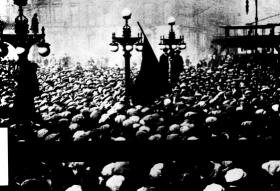
‘Red Clydeside’—workers’ demonstration (with red flag) in George Square, Glasgow, in 1919. (Scottish Media Newspapers)
The most dangerous man in Britain’ or a paranoid crank? ‘The greatest fighter of the Scottish working class’ or a middle-class intellectual out of touch with working-class opinion? A Marxist ‘first, last, and always’ or a Communist Party heretic? A Scottish patriot on a par with William ‘Braveheart’ Wallace or a minor footnote to history? The man behind such divergent assessments is John Maclean (1879–1923), the Scottish revolutionary socialist and republican who, at different times, was the most successful grass-roots Marxist educator in Europe, an international pacifist martyr, Bolshevik consul for Scotland, and founder of the Scottish Workers’ Republican Party (SWRP).
Maclean’s legacy is complicated by the years following the First World War, when he emerged as a fierce critic of the nascent Communist Party of Great Britain (CPGB) and launched his rival initiative for a Scottish Workers’ Republic. Maclean’s divisiveness stirred leftist controversy at the time, and continues to fuel debate among scholars regarding nationalism’s place in his revolutionary politics. For students of Irish history, that debate will bring to mind James Connolly, Ireland’s most important Marxist, whose decision to participate in the Easter Rising provoked similar questions about the compatibility of nationalism and socialism. Indeed, there are a host of intriguing parallels and connections between Maclean and Irish figures like Connolly, Constance Markievicz and Jim Larkin, with whom he shared space in radical newspapers and on speaking platforms. While not initially sensitive to Irish nationalist aspirations, from 1919 Maclean became increasingly supportive of, and influenced by, the principles and tactics of the Sinn Féin movement. Attention to the overlooked Irish dimension of Maclean’s career helps to clarify the role nationalism played in his post-war revolutionary strategy, and it also illustrates some of the ripple effects that the Irish Revolution produced beyond Ireland. His speeches and writings allow us to trace his evolving attitude towards Ireland, while a letter protesting against Irish Free State executions preserved in the National Archives of Ireland offers a snapshot of his views at the height of the Civil War.
‘The fighting dominie’ [Scots for schoolmaster]
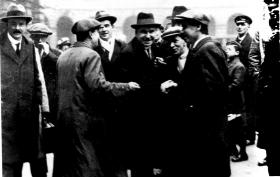
John Maclean (centre) sharing a joke with comrades during a strike in 1919. In the same year he visited Dublin for the first time and was forced to confront several of his ideological blind spots on the ‘Irish Question’. (Glasgow Museum)
John Maclean was born in 1879 in Pollokshaws, at that time a village on the outskirts of Glasgow. His parents were artisans and congregants of the Original Secessionist Church. Both were Gaelic-speakers whose families, like thousands of others, had settled around Glasgow after being driven from the Highlands by poverty, evictions and rack-rents. (Irish Land League founder Michael Davitt turned his attention to these ‘crofters’ in his Scottish land agitation of the mid-1880s.) Despite being widowed, Maclean’s mother saw to it that all of her children received an education. John attended the Free Church Training School, became a certified teacher in 1900, and later received an MA from Glasgow University, where his favourite subject was Marxist economics.
While teaching for the Govan School Board, Maclean joined the Social Democratic Federation (SDF). He was a vital force within the SDF, juggling his job as a schoolteacher with work on the propaganda front, in the cooperative movement and as the organiser of evening classes on the fundamentals of Marxism that radicalised thousands of workers. In 1907 he was invited to speak in Belfast by Jim Larkin, then leading a series of historic strikes there. The two men became friends and mutual supporters, but Maclean’s first Irish sojourn did not advance his views on the ‘Irish Question’. With a Scottish Protestant upbringing imparting an Orange hue to his anti-clerical political principles, he feared that anything beyond Home Rule for Ireland would result in a reactionary Catholic state. His antipathy to the Catholic Church and his advice to Scotland’s sizeable Irish Catholic population (concentrated in Glasgow, where roughly 7% of the city’s one million inhabitants were Irish-born and many more were descendants of nineteenth-century immigrants) to put class interests before nationalism prevented him from making headway with that community before the war.
As the pre-war arms race between Britain and Germany pushed munitions production to new levels, labour discontents came to the fore in Clydeside’s heavy industries. Maclean helped to organise strikes and agitations for a minimum wage and for rent reductions. When war began in August 1914, Maclean, unlike many of his backsliding comrades, remained faithful to the anti-war principles of the Second International and emerged as the most prominent socialist opponent of the war in Britain. His anti-war speeches and demonstrations outside recruiting stations violated the wartime Defence of the Realm Act (DORA), leading to his first serious conviction in 1916. His trial took place around the same time
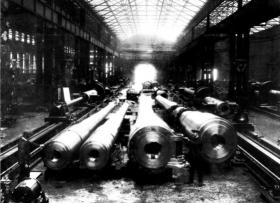
Left: Parkhead gun factory, Glasgow. As the pre-war arms race between Britain and Germany pushed munitions production to new levels, labour discontents came to the fore in Clydeside’s heavy industries. (Glasgow University)
that the IRB and the militant rump of the Irish Volunteers launched the Easter Rising in Dublin with the assistance of James Connolly and the Irish Citizen Army. Like most British socialists at the time, Maclean had difficulty comprehend-ing why the socialist Connolly would participate in a ‘mere’ nationalist rising. In the dock, Maclean underscored the difference between himself and Connolly by asserting that while physical-force methods ‘might be good enough for men in Dublin’, they were inappropriate for the Clyde workers’ movement.
Maclean was released after a year amidst growing popular anger at his imprisonment, which, according to some accounts, caused him to suffer a mental breakdown. (His critics on the left argued that he never recovered.) He resumed his place in the vanguard of the workers’ and anti-war movements just as the Bolsheviks were seizing power in Petrograd in October 1917. Developments in Russia had a catalysing effect on socialists everywhere, and especially on Maclean, who became convinced, like Connolly before him, that the only way to stop the war and usher in an international socialist order was through revolutionary action at home. Arrested again in early 1918, Maclean was imprisoned for the rest of the war. Convinced that the prison authorities were drugging his food, he refused to eat. The use of stomach pumps to force-feed him prompted future prime minister Ramsay MacDonald to protest that Maclean ‘was being worse treated than Sinn Féiners’ (an allusion to republican hunger striker Thomas Ashe, who died from similar treatment the previous year). Meanwhile, the Labour Party emulated the Sinn Féin tactic of ‘putting him in to get him out’ by running Maclean as a parliamentary candidate.
‘Keeping capitalism busy at home’
When Maclean was released after the armistice, Sinn Féin was on the verge of its sweeping victory in the general election of December 1918, which ushered in the first Dáil and the start of the IRA’s guerilla campaign. To most British socialists, the nationalist ferment sweeping not only Ireland but also the Irish immigrant communities in their midst (Glasgow alone boasted nine IRA companies and dozens of republican clubs) was largely irrelevant to the pressing tasks of supporting the embattled Soviet Republic and setting up a disciplined Communist Party for Britain. But for Maclean, who had come to feel that the best way to support the Bolsheviks was by ‘keeping capitalism busy at home’, Irish republicans’ campaign of resistance to British rule had profound implications for the revolutionary struggle within the British Empire.
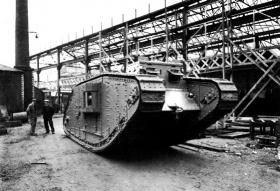
Mark IV tank manufactured in Glasgow during the First World War. (Glasgow University)
One of the first signs that Maclean had become more receptive to forging connections with Irish separatists came in a June 1919 piece that he published on the occasion of the James Connolly birthday celebrations in Ireland. Taking aim at ‘the priests of capitalism (British and Irish alike)’ who suppressed working-class educational initiatives only to hypocritically accuse the Catholic clergy of ‘keep[ing] the Irish workers in ignorance’, Maclean pledged on behalf of Scotland to ‘send help to Ireland to establish her Connolly College’. A month later, Maclean visited Dublin for the first time, where he was exposed to the large British military build-up in Ireland and was forced to confront several of his ideological blind spots on the ‘Irish Question’. In his ‘Impressions of Dublin’, Maclean recounted a speech he gave there in which he indelicately asserted the inadequacy of a Sinn Féin republic for the emancipation of Irish labour because Ireland’s freedom ‘depended on the revolt and success of British labour’. Given the militant mood in Ireland, Maclean’s suggestion that ‘Irish workers ought not to antagonise the soldiers of occupation in Ireland, but should try to win them over to the Irish point of view’ was sure to raise Irish hackles. Indeed, over the next several days he encountered ‘keen criticism and opposition’, ranging from ‘good-natured correction’ of his reference to Britain as ‘the mainland’ to hostile questioning about the presence of Scots troops in Ireland. Maclean welcomed the ‘frank interchange of viewpoints’ and returned to Scotland fired by the Irish national spirit ‘that 900 years [sic] of oppression had failed to subdue’.
‘The Irish fight for freedom’
By mid-1920 Maclean was penning pieces such as ‘The Irish fight for freedom’, in which he echoed many of Sinn Féin’s arguments and rhetorical strategies. He seized on the 1918 and 1920 elections as a popular mandate for independence, stressed the emptiness of Britain’s wartime rhetoric of defending democracy given its own record of repression, and used Terence MacSwiney’s death on hunger strike as a moral indictment of British rule. Whereas the Maclean who travelled to Ireland in 1919 advocated moral suasion, by 1920 he rivalled the Irish Volunteers’ own journal, An tÓglach, in his enthusiasm for physical-force methods. He defended the shooting of Irish constables (‘scabs and traitors to their race’) and condoned the assassination of resident magistrate Alan Bell by asking, ‘What self-respecting man or woman can blame the Irish for ridding the earth of such a foul skunk?’
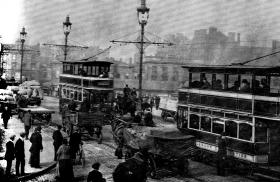
Traffic on Jamaica Bridge, Glasgow, c. 1914. (Glasgow City Archives)
Maclean’s conversion to Irish republicanism, while genuine, must ultimately be seen in the context of the deeper motives and political considerations that informed it. Chief among these was his Marxism, which committed him to advancing the cause of international socialism. Thus for Maclean, the future Irish Republic must be a ‘workers’ republic’ set up along socialist principles and fully engaged in the worldwide struggle against capitalism. This harnessing of Irish republicanism to a socialist agenda had an obvious precursor in James Connolly. Although the two men never met, Connolly’s earlier example cannot but have made an impression on Maclean (though he occasionally insisted that the influence was the other way round!). In his effort to synthesise the class and national struggles, Maclean encountered some of the same conceptual difficulties that Desmond Greaves later observed in Connolly’s thought. At times, Maclean appeared to regard Irish republicanism as an intrinsically progressive force, since by taking up arms against British rule ‘Irish Sinn Féiners, who make no profession of socialism or communism . . . are doing more to help Russia and the revolution than all we professed marxian Bolsheviks in Britain’. At other times he dwelled on the fundamental clash of interests between Irish workers and ‘Sinn Fein members of the propertied class’, and predicted that after Irish independence a spontaneous class war would ‘burst out’, converting the nascent republic into a socialist one.
At root, Maclean understood Ireland’s significance for the socialist cause in anti-imperialist terms. He regarded Ireland’s struggle for independence as the gravest threat to the British Empire, the destruction of which was a prerequisite for the liberation of the workers of the world. The achievement of independence for Ireland would act as ‘the inciting influence to British labour’, bringing the empire ‘crashing to the ground’ and producing global revolutionary shockwaves. Maclean’s advocacy of Irish independence had impeccable Marxist credentials—before Connolly, Marx and Engels had written extensively on the centrality of Irish national liberation to social revolution in Ireland and Britain. Nevertheless, most contemporary Marxists failed to share his enthusiasm for the rather socially conservative independence movement in Ireland. But Maclean was buoyed in his belief that ‘Ireland’s victory is obviously the undoubted prelude to labour’s triumph throughout the world’ by two developments he mistakenly assumed to be on the horizon. The first of these was the ‘coming war’ between Britain and America for global hegemony in which, he imagined, a socialist Irish republic hostile to British interests would play a pivotal role. He also invested great significance in the Connaught Rangers mutiny of June/July 1920, in which hundreds of Irish soldiers in India refused orders as a protest against repression in Ireland. Although the mutiny was quickly suppressed, Maclean regarded the incident as being ‘pregnant with great historic results’ and held out hope that the spirit of insurrection would spread throughout the British Army.
A latent strain of Scottish nationalism also coloured Maclean’s thinking on Ireland. A long-time critic of moderate Scottish Home Rulers, Maclean’s deepening engagement with Irish republicanism eventually inspired him to cooperate with more advanced nationalists in the hopes of creating a Sinn Féin-style agitation for Scotland. In 1920 he announced his new commitment to Scottish independence in the mass-produced pamphlet All Hail, the Scottish Workers’ Republic!, and in 1923 he established the SWRP to contest elections on an abstentionist platform.
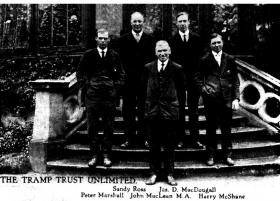
‘The Tramp Trust Unlimited’—Maclean and his socialist missionaries in 1922. (The Herald)
Pan-Celticism
While Maclean undoubtedly embraced Scottish (and Irish) separatism as the shortest path to imperial collapse and world revolution, there is an under-appreciated romantic nationalist dimension to his thought. The theme of a pan-Celtic identity runs through his later writings, particularly in the context of his outrage at the deployment of Scottish regiments in Ireland. In denouncing Scottish complicity in Ireland’s repression, Maclean often appealed to Scotland’s own tradition of resistance to ‘the Sassenachs’:
‘To every Scotsman who has felt proud of Scotland’s political and religious fights against England . . . the blush of shame must come when we learn that Scottish boys are to be used to prevent by murder the Irish race from attaining that very freedom . . . our fathers fought to preserve.’
He occasionally indulged in explicitly ethnic appeals, asserting the common ethno-cultural roots of the Scottish and Irish ‘races’ and the existence of deep-seated cultural affinities between ‘the Celts of Scotland and the Celts of Ireland’. By cribbing a little from the Edinburgh-born Connolly, Maclean conveniently claimed that the ‘tradition and the instincts of the Celtic race’ were proto-socialist in character.
How, one might wonder, did Maclean reconcile his vision of pan-Celtic solidarity with the vexing realities of working-class sectarianism? Maclean knew well the intensity of popular sectarian animosities. Speaking in 1920 in Motherwell, a Scottish town with a large Irish population, Maclean was heckled by ‘Orange hooligans’ before the crowd broke up into hostile Orange and Green factions. He attempted to link Irish independence to Scottish workers’ own economic interests by arguing that it was British policy to ‘starve [Irish] youths out of their native land’ and that Irish independence would therefore mean fewer Irish immigrants competing with native workers for jobs along the Clyde. Thus, rather ingeniously, he sought to mobilise Scottish nativist and sectarian animus against the Irish in support of Irish national aspirations. But while Maclean went to great lengths to convince Scotsmen of the advantages of an Irish republic, he was considerably less patient in dealing with the Protestants of Ulster: ‘If Ulstermen cannot tolerate an Irish republic, let them take a taste of emigration’.
‘John Bull Imperialism’ and the Irish ‘Free’ State
In October 1921, as the Anglo-Irish Treaty negotiations commenced in London, Maclean was sentenced to a year in prison for making ‘seditious’ comments at a rally for unemployed workers. When he was released, the Irish Revolution he had come to champion had gone far off course. Instead of fighting Britain for a republic (and thereby advancing the global anti-imperialist cause), Ireland was embroiled in a civil war in which a new native government defended a settlement that left the British Empire intact. A particularly embittering aspect of the conflict was the Irish Free State’s execution of over 80 republican prisoners in reprisal for IRA attacks.
A Department of An Taoiseach file at the National Archives contains correspondence received on the eve of one of the first and most controversial executions, that of republican propagandist Erskine Childers on 24 November 1922. Alongside letters of protest from Gaelic League founder Douglas Hyde, painter Jack B. Yeats and others is a powerful letter from Maclean. Addressing himself to ‘President Cosgrove’ [sic] on behalf of ‘Four thousand “Red” and “Green” supporters of my fight for a Scottish Workers’ Republic’, Maclean expressed ‘dismay and disgust’ at the execution of four republican soldiers three days earlier (the first under the Public Safety Bill). After acknowledging ‘the tight corner into which John Bull’s Government has placed the Irish “Free” State’, he assumed a more characteristically militant tone: ‘Further executions will reduce you and your colleagues to the level of Smuts, the blood-stained tool of John Bull Imperialism and Rand Gold Mine Capitalism’. His comments refer to the ‘Rand Revolt’ of early 1922, during which white South African workers lashed out against wage cuts and job competition from non-whites with a wave of strikes, racial attacks and paramilitary violence that revolutionaries tried to channel against the state. The execution of four strikers by the government of Boer-rebel-turned-prime-minister J. Christian Smuts provided an obvious parallel between South Africa and the Irish Free State. (At the time, Liam Mellows and others drew similar parallels.) Arising from his internationalist outlook, Maclean’s reference to South Africa is unintentionally ironic given Childers’s distinguished service in the British Army during the Anglo-Boer War.
Little over a year later Maclean was dead, his revolution unfinished and the workers’ republics he sought still out of reach. Whatever about his place in the history of European socialism or Scottish nationalism, his passionate engagement with Ireland’s struggle for independence—in particular his insistence on its imperial context and potential global significance—deserves consideration in any thorough examination of the Irish Revolution.
Gavin Foster is a doctoral student in history at the University of Notre Dame.
Further reading:
I. McLean, The legend of Red Clydeside (Edinburgh, 1983).
N. Milton (ed.), In the rapids of revolution (London, 1978).
B. J. Ripley and J. McHugh, John Maclean (Manchester, 1989).
















